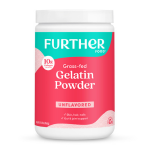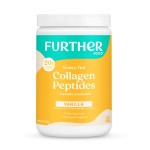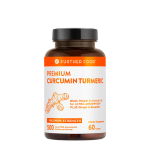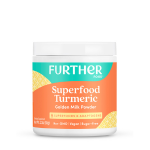My Autoimmune Journey: I Could Have Saved My Thyroid If I Knew Then What I Know Now

I couldn’t believe this was happening to me.
I was lying in bed, clutched in the grip of a panic attack. I wanted desperately to continue with my second year of medical school. But I was struggling with the nightmarish symptoms of Graves’ disease, an autoimmune condition in which the thyroid gland attacks itself and overproduces its own hormone. Awful as the symptoms were, the helplessness was worse — the feeling that my life was no longer my own.
The first signs had shown up early into my second year of medical school at Louisiana State University Health Sciences Center in New Orleans. As happens with most autoimmune disorders, I had no idea what was going on. For the first time in my life I was seized by panic attacks. Despite barely exercising and consuming massive quantities of pizza and oatmeal cookies, I was shedding weight like a marathon runner. I went from a size 4 to a size 0 within a few months. Yeah, that sounds like the ideal weight-loss plan, but in fact, it was terrifying to suddenly drop so much weight for no apparent reason. I was always in a mild sweat. My heart never stopped racing. My mind was racing too, partly from the disease and partly because I was just so scared. I never knew when a panic attack might strike. My legs were so weak, they shook every time I went down a flight of stairs. When I picked up a pen to take notes in class, my hand shook with a tremor I could barely control.
Then the insomnia kicked in. I tossed and turned, night after night. If you’ve ever had insomnia of your own, you know what a torment it can be to lie awake for hours at a time, crazed with exhaustion and yet unable to fall asleep. Soon, the prospect of facing another sleepless night becomes almost as bad as the insomnia itself. I felt as though I were living in a prison of anxiety, dizziness, and fatigue. “There has to be a solution,” I told myself as I stared miserably at my peacefully sleeping dog, Bella. But this was my life now, and I couldn’t help wondering whether this would always be my life.
Finally, my tremor got so bad that my friends noticed it. They were alarmed and convinced me to go see a doctor — who quickly brushed aside my concerns.
“I think this is just stress,” she said briskly. “You’re a second-year medical student, and it’s very common to think you have every disease you’re currently learning about. I wouldn’t worry about it.”
Painful as her response was, it provided a valuable lesson. Today, when a patient comes to me in tears, insisting that there’s a part of her story that her physician has overlooked, I am always ready to hear her out. “You know your own body better than I do,” I tell my patients, wishing that first doctor had said something similar to me.
At least I knew enough to trust my own instincts. After all, I’d been through plenty of stressful times in my life, and I’d never responded like this. Like the feisty Louisiana woman I had been raised to be, I demanded a full workup and lab testing.
It turned out my instincts were right on the money. I wasn’t just panicking over courses and exams. I wasn’t mysteriously going insane. I had an actual, diagnosable condition: Graves’ disease. Finally, my misery had a name.
Graves’ disease is a condition in which the thyroid overperforms. It enlarges to up to twice its normal size, producing all the symptoms I had been suffering from: racing heart, tremors, muscle weakness, disturbed sleep, excessive weight loss. Learning the name of my condition was just about the last comfort I got, however, because the conventional medical treatments for Graves’ were pretty terrifying. There were three choices on the menu, and none of them seemed like the route to a happy life.
The first and least invasive choice was to take a drug known as propylthiouracil (PTU). The PTU was supposed to stop my thyroid from working so hard and keep it from overproducing the hormone.
That sounds good, right? Then I looked at the side effects. Here’s just a partial list: rash, itching, hives, abnormal hair loss, changes in skin pigmentation, swelling, nausea, vomiting, heartburn, loss of taste, joint or muscle aches, numbness, and headaches. A less common but still possible side effect related to the therapy is a condition known as agranulocytosis, which is a decrease of white blood cells, bringing with it infectious lesions of the throat, the gastrointestinal tract, and the skin, along with an overall feeling of illness and fever.
Okay. What were my other options?
Well, basically they were two different ways of destroying my thyroid gland. I could have it removed surgically. Or I could have a procedure known as thyroid ablation, which involves swallowing a radioactive pill to kill the gland.
Despite my enrollment in a conventional medical school, I believed there were other roads to health besides medications and surgery. For example, nutrition was clearly instrumental in short-term and long-term health.
When I was a kid, my mom made much of our food from scratch: whole-wheat bread, plain organic yogurt, granola and oatmeal cookies, and peppers and tomatoes that she grew right in our own garden. We didn’t go in for packaged, processed foods; we barely had any canned foods in our cupboards. We always ate our meals together, as a family — mostly 1970s health food, like brown rice, tofu, sprouts, and vegetables. We rarely got sick, and I was proud of the healthy diet that kept us well. At age fourteen, I even became a vegetarian.
Then my mom got cancer.
She was only fifty-nine at the time, and I was only twenty-nine. I had just spent two exciting years as a Peace Corps volunteer in rural Paraguay and was back in the States, completing my prerequisites for medical school. When I got the news about my mom, I simply couldn’t believe it. My mother had always been the vision of health. She looked ten or fifteen years younger than her actual age, jogged three miles each day, and even taught yoga. But out of the blue she had been diagnosed with pancreatic cancer, a disease for which conventional medicine has no cure.
That was a real wake-up call for me. I discovered that you can be doing all the right things — or what you believe to be the right things — and still get terribly ill.
To some extent this is because most serious illnesses are multifactorial. Genetics plays a role. So does our toxic environment. We don’t have perfect control over the conditions that create our disorders.
I also discovered — although not for several more years — that our “healthy” family diet had actually been poisoning us all. The whole-wheat bread, grains, and legumes that formed the basis of our family meals were full of inflammatory chemicals that might well have triggered my mom’s cancer, worsened my father’s autoimmune disease (a condition known as polymyositis, marked by joint pain and muscle weakness), and set me up for my own health problems.
Meanwhile, Mom’s illness made it crystal clear how completely resistant most conventional doctors are to any unconventional approach, especially when it concerns nutrition, supplements, or something natural. When I asked Mom’s doctor about some new healing foods I had learned of, her doctor simply scoffed, mocking the very idea that nutrition could play a major role. “Your mom could put a watermelon in her ear and jump up and down on one foot, and that might help too, but it probably won’t,” he told me. As I prepared for medical school, I understood that this response would be typical of the mindset I would encounter. My plan from the start had been to become an integrative physician who viewed the body as a whole and used diet and natural approaches as much as possible. Mom’s experience simply confirmed just how difficult it would be to integrate these two approaches.
Meanwhile, conventional medicine could offer my mother nothing except chemotherapy, which they didn’t even expect to provide a cure, only to delay the inevitable. My mother died less than five months after she was diagnosed. I entered medical school the following year — and one year later I was suffering from Graves’.
I now know that besides diet, stress is a big factor in the development of autoimmunity. The stress of my mother’s death had clearly helped to trigger my Graves’ disease. But there were other factors involved as well:
Diet: As a vegetarian, my diet was based on lots of gluten, grains, and legumes, as well as dairy products, nuts, and seeds. These seemingly healthy foods had actually inflamed my system, setting me up for problems with my immune system. If, like many people, I had a genetic predisposition to autoimmunity, this diet would virtually ensure that my predisposition would turn into a full-blown disease.
Leaky gut: My carb-heavy diet set me up for a condition known as “small intestine bacterial overgrowth (SIBO),” which in turn created leaky gut, in which my intestinal walls became permeable, with dangerous consequences for my digestive and immune systems.
Toxins: Heavy metals are another factor in triggering autoimmune conditions, and I had had a lot of exposure to mercury: through the weekly vaccinations I got in the Peace Corps, in all the canned tuna I loved to eat, and on an extended stay in China, where the air pollution is loaded with heavy metals. Had I reduced my exposure to mercury, I could have lightened my toxic burden and perhaps my immune system would not have gone out of whack.
Infections: Certain types of infections are another risk factor for autoimmunity. And guess what. I had had one of them: the Epstein–Barr virus (EBV), which had given me a bad case of mononucleosis when I was in high school. The EBV is also implicated in chronic fatigue syndrome, which is why people who suffer from that condition are also at risk for autoimmune disorders.
If I had known then what I know now, I would have understood how many risk factors I had — and I would have known how to use diet, gut healing, detox, and stress relief to prevent my condition. Had I still succumbed to an autoimmune disorder, I would at least have been able to treat myself, easing my symptoms, regaining my health, and avoiding the horrific options offered by conventional medicine.
But this was back in the year 2000, and functional medical approaches were in their infancy. My conventional doctors gave me the three unpleasant options, and as far as I knew, those were the only choices I had.
Hoping for a better way, I went to a traditional Chinese doctor and started taking lots of herbs in the form of terrible-tasting brown powder. They didn’t seem to do much good, plus I was concerned that if I ever needed emergency treatment, the ER docs would have no idea about potential cross-reactions — they wouldn’t even know what I had been taking. Despite my growing lack of faith in conventional medicine, I did not want to abandon it entirely.
So, reluctantly, I opted for the PTU. I got my first lesson in the potentially disastrous side effects when I developed toxic hepatitis a few months later as the prescription drug started destroying my liver. The condition was so severe, I was sent for extended bed rest and nearly had to drop out of medical school.
My choices were now surgery or ablation — remove my thyroid or destroy it. Meanwhile, I was still eating my “healthy” grain-based diet, which was still causing my immune system to attack my thyroid.
I chose ablation and said good-bye to my thyroid, a choice I regret to this day. If only I had known about functional medicine, I might still have my thyroid today, living symptom-free and healthy with my body intact.
At the time, though, I knew no other way. I just have to tell myself that I did the best I could with the knowledge I had.
Yet even then I intuitively knew that there was a better way — an approach to health that worked with the body’s natural healing ability instead of attacking the body with harsh drugs and invasive surgery. I had always known that some other type of medicine existed, even though I didn’t know what it was called or how to find it. I had entered medical school committed to finding this other type of healing, and I sought out every possible place where I might learn more about integrative and alternative medicine. I was even president of my medical school’s complementary and alternative medicine interest group. But no approach I found seemed to get to the root of the problem.
So when I graduated from medical school, I decided to go into emergency medicine. With that specialty, I could always work in international health, which had been my love in the Peace Corps. And since ER doctors don’t have an established practice, I would be free to pursue that other type of medicine — as soon as I knew what it was.
I moved to Austin, Texas, where my time was split between the main trauma center at Brackenridge Hospital and the pediatric trauma center at Dell Children’s Medical Center. As an emergency room physician, I had the opportunity to treat people in the most extreme conditions, and I was proud of the lives I helped to save. Bringing a child back from the verge of death, and knowing that I had helped not just him but his entire family, made me remember all over again how powerful the right treatment can be.
Yet the vast majority of the people I saw were not coming in for trauma but because of something related to a chronic disease. This was truly heartbreaking, because conventional medicine could do so little to help them. Not only had conventional medicine failed me, now it — and I too — were failing them.
Meanwhile, my own health problems continued. The ablation had released large amounts of thyroid hormone into my bloodstream, which meant that for months I suffered from severe mood swings. Because my system was still inflamed, I developed irritable bowel syndrome (IBS). Even when the worst of my symptoms abated, I never felt really healthy. The best I could feel was “not sick.”
Then, finally, I found what I had been looking for. I discovered functional medicine.
Excerpted with permission from The Autoimmune Solution by Amy Myers, MD.
Want more? You might also like:
My Nourishing Three Day Meal Plan For Living With Lupus, Fibromyalgia and Multiple Autoimmune Conditions
When Your Autoimmune Disease is Especially Unbearable, Consider These 10 Tips
The Mortifying Way I Discovered My Autoimmune Disease
In My Pantry: 10 Foods to Fight Autoimmune Flares
The Diet That Changed My Life with IBS and Improved My Thyroid Symptoms
Note: PLEASE consult with your doctor before making any changes to your diet or medications. The material on this site is provided for educational purposes only, and is not to be used for medical advice, diagnosis or treatment.
























